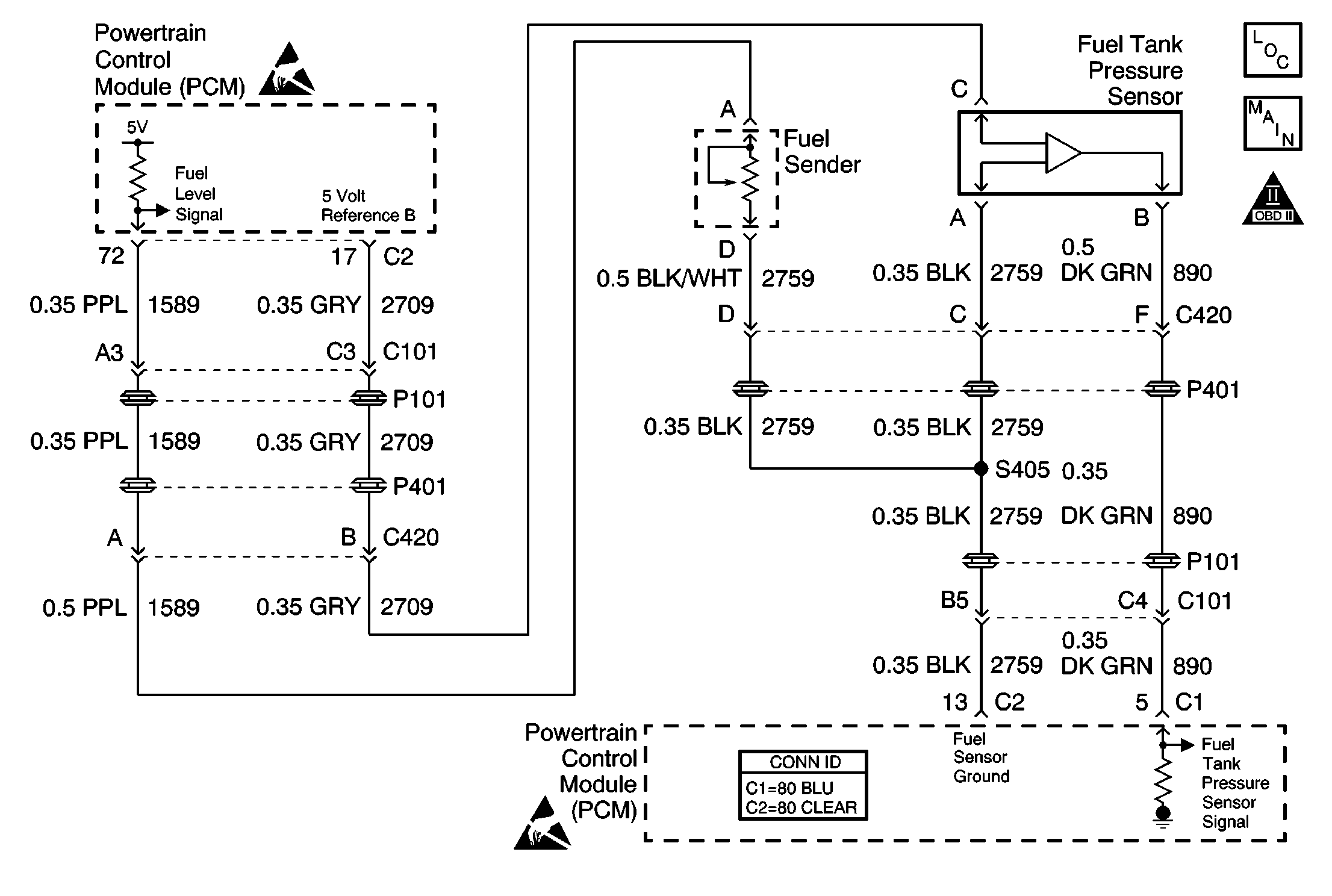
Circuit Description
The fuel level sensor is a device used to determine the level of fuel in the tank. The PCM applies an ignition voltage to the sensor. The sensor varies the voltage based on the level of fuel in tank. When the tank is full, the sensor resistance is high, and the PCM senses a high signal voltage. As the fuel level in the tank decreases, the sensor resistance drops, and the signal voltage at the PCM is pulled low. The PCM uses the fuel level input run certain system tests. Some of these system tests include the following:
| • | EVAP system |
| • | Misfire |
| • | Oxygen sensor |
The PCM also sends the fuel level information via class 2 serial data to the IPC. The IPC uses the information to control the fuel gauge.
The PCM monitors the fuel level sensor to detect a fixed signal voltage. The PCM checks for a change in signal voltage (tank volume) over a calibrated distance. If the signal voltage indicates that the change in tank volume is less than the calibrated amount, the PCM will set DTC P0461.
Conditions for Running the DTC
| • | No VSS DTCs are set. |
| • | The engine is running. |
| • | System voltage is between 11 and 16 volts. |
| • | Vehicle speed is more than 5 km/h. |
Conditions for Setting the DTC
The fuel level sensor voltage indicates that tank volume has not changed over a distance of 60 kilometers (37.5 miles).
Action Taken When the DTC Sets
| • | The PCM will not illuminate the malfunction indicator lamp (MIL). |
| • | The PCM will store the conditions present when the DTC set as Failure Records data only. |
Conditions for Clearing the MIL/DTC
| • | The history DTC will clear after 40 consecutive warm-up cycles have occurred without a malfunction. |
| • | The DTC can be cleared by using the scan tool Clear DTC Information function. |
Diagnostic Aids
Important: Fuel level is used to determine EVAP system diagnosis. Always diagnose the fuel level sensor before any other EVAP system components or DTCs.
For additional diagnostic information, refer to Diagnostic System Check - Instrument Cluster in Instrument Panel, Gauges, and Console.
Reviewing the Fail Records vehicle mileage since the diagnostic test last failed may assist in diagnosing the condition. The information may help determine how often the condition that set the DTC occurs.
Step | Action | Values | Yes | No | ||||
|---|---|---|---|---|---|---|---|---|
1 | Was the Powertrain On-Board Diagnostic (OBD) System Check performed? | -- | ||||||
2 | Are there any Instrument Panel Cluster (IPC) DTCs set? | -- | Diagnose the IPC DTCs first | |||||
3 |
Does the DMM display a voltage near the specified value? | B+ | ||||||
4 |
Does the fuel gauge indicate EMPTY? | -- | Go to Diagnostic Trouble Code (DTC) List - Instrument Cluster/Driver Information System | |||||
5 |
Was a problem found? | -- | ||||||
6 |
Does the DMM indicate a voltage near the specified value? | B+ | ||||||
7 |
Was a problem found? | -- | ||||||
8 | Replace the fuel level sensor. Refer to Fuel Level Sensor Replacement . Is action complete? | -- | -- | |||||
9 | Locate and repair the cause of high resistance in the fuel level sensor ground circuit. Refer to Wiring Repairs in Wiring Systems. Is action complete? | -- | -- | |||||
10 |
Important: The replacement PCM must be programmed. Replace the PCM. Refer to Powertrain Control Module Replacement/Programming . Is action complete? | -- | -- | |||||
11 |
Does the scan tool indicate that DTC P0461 failed this ignition? | -- | System OK |
